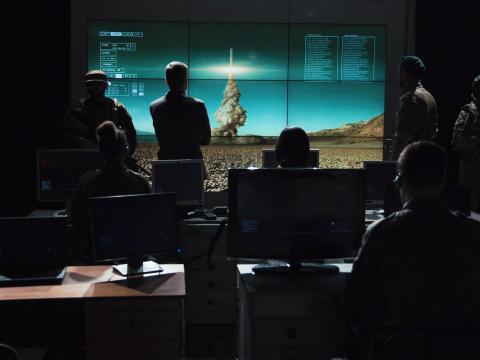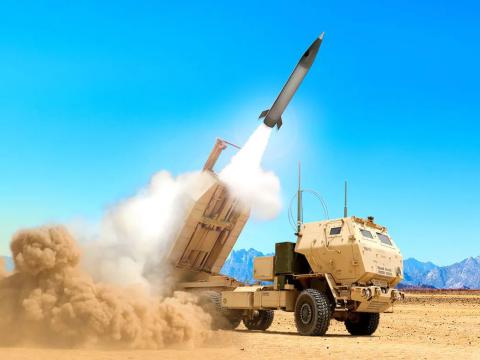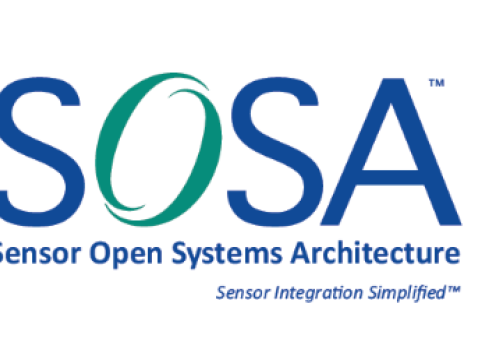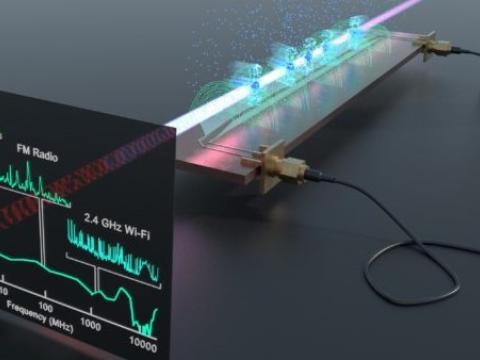A New Role for Maritime Headquarters
 |
| The Maritime Headquarters with Maritime Operations Centers (MHQ with MOCs) will boost the U.S. Navy’s ability to work with combined and joint air operations centers. This particular team monitored the skies over the Baltic countries during NATO’s Riga Summit in Latvia in 2006. |
The
At the core of this initiative are the Maritime Headquarters with Maritime Operations Centers (MHQ with MOCs). By fiscal year 2014, these centers will be standardized from top to bottom and side to side, boosting flexibility and agility but leaving enough room for regional differences and requirements. The work to bring consistency within the current 12 MOCs will be conducted in spirals. By fiscal year 2010, the Navy will have transitioned from its current systems-centric environment to an application-centric operational design. Approximately 70 percent to 80 percent of the applications Navy organizations use will be the same, allowing some uniqueness for geographic and cultural differences. By fiscal year 2012, the service will be at the wide area network standardization level and will be moving toward being service-centric. Consequently, it will be buying fewer systems but more services. Finally, by fiscal year 2014, the Navy will be a fully service-oriented architecture.
Capt. Michael Smack, USN, director, MHQ with MOC, Second Fleet,
Capt. Smack describes the MHQ with MOCs as a multinode system of systems. Each headquarters is a node; each node relies on other nodes as well as other naval organizations such as the Office of Naval Intelligence and the
This global network will enable the Navy to progress incrementally, which the captain describes as a crawl-walk-run. At the crawl stage—where the Navy now confidently resides—command, control, communications, computers and intelligence (C4I) assets allow naval organizations to share information in a consistent, reliable and assured fashion. At the walk stage, organizations can collaborate in their knowledge-gathering and decision-making efforts to create trans-regional plans such as a maritime security plan that supports the U.S. Central Command. Once technology, processes and procedures are essentially consistent across the MHQ with MOCs, the Navy will have reached the run stage, and multiple headquarters will be able to execute those collaboratively formed plans in coordinated operations.
To attain the run stage, Capt. Smack says the Navy must solve some C4I standardization issues as well as address the lack of consistency in the collection of intelligence, surveillance and reconnaissance (ISR) information, analysis and dissemination. “We have to take it up in the cognitive hierarchy of development. Data and information are really important, but if we stopped there, we’d only be at the crawl stage. We have to get up to the knowledge and the understanding levels so that two groups can have similar knowledge and can have similar understanding and make decisions about a coordinated plan. Then we can move beyond that up to the decision making, the action and the effects,” he explains.
To achieve this goal, the Second Fleet team coined the term “Global First.” Everything that is designed—from technology to processes—for the MHQ with MOCs will apply across the board. For example, the final process for disseminating information must be relatively appropriate for each of the centers. “We’re really trying to work on finding all of those things that we agree upon that are common and then build that foundation of commonality. And the C4I industry has some great standards and foundational work that we can use,” the captain says.
And the MOCs are by no means a small portion of the maritime headquarters. As the captain describes it, the MOC is two-thirds of the headquarters and focuses on the assigned operations; the remaining one-third handles the service requirements such as staffing, training and logistics.
 |
| Not all operations centers operate with the latest in technologies. Col. Kenneth Madden, USA, issues instructions during a hurricane response exercise in a U.S. Army Operations Center at Fort Belvoir, which features a large map of the area of operations on its floor. |
“In the maritime world, we tended to be a force provider at that time. We would provide air assets into the air picture; we would provide land assets to support the fight. But the Navy was not yet fully integrating the maritime domain. So it was around the end of the 1990s when the Navy began to realize that it needed to also engage in deconfliction, synchronization and then integration of operations in the maritime domain,” Capt. Smack explains.
This situation led the Navy to its work on the Joint Force Maritime Component Command, or JFMCC, a complex effort because of the way the service handled training and career advancement. “For the longest time, the Navy trained its personnel, even the officers and senior leaders, to come up through the tactical ranks. We’re trained to be weapons experts, platform experts or force unit experts. We realized that we did not spend as much time as the Marine Corps, the Army and the Air Force training people in the big picture,” the captain allows.
As a result of this shortfall, the Navy did not have the cadre of professional planners at the operational level that the other services had when the
The service could not have chosen a better time to undertake this shift. In early 2005, Donald Rumsfeld, then secretary of defense, called for an increase in the number of joint task forces (JTFs). Later that same year, presidential directives drawing attention to national security, and in particular national maritime security, were issued. And although the Navy had been fulfilling a role in several JTFs in the Pacific region, these new marching orders called for the service to start thinking globally. As a result of the new mandates, the ongoing work on JFMCCs grew from concentrating on integration across the maritime domain to the current efforts to ensure that the service is able to lead JTFs in a variety of operational missions across the globe.
“So it was those three elements—the JFMCC focus, the desire to form and sustain more JTFs and the need for a national strategy for maritime security—that coalesced and led to the decision that maritime headquarters that support security locally, regionally and globally needed to go on par with air operations centers and tactical operations centers,” Capt. Smack says.
The need to enhance the Navy’s capability to handle a broader range of integrated responsibilities has become more evident as its work with the
In determining how best to support these joint missions, the Second Fleet’s MHQ with MOC team has taken an in-depth look at information sharing and information technology. In the past, Capt. Smack explains, the Navy’s focus in terms of information was very local. Carrier strike groups operating in designated areas would possess the majority of the C4I equipment, and the numbered fleets had to rely on these groups for information.
“As we looked at this configuration, we realized that it’s a little backward. It should be the higher commands that are gathering information of an important nature—strategic and operational nature—using it and pushing it down to the tactical forces. In the same vein, they also should be taking information of a very detailed nature that is developed by the tactical forces, pulling it out and then pushing it out to other components, services and so forth. So where the Navy for a long time has been working the ‘up and out’ flow of information, it has not been working the ‘in and down’ to the same degree.
“We wanted all of these headquarters to be able to gather and fuse information and knowledge in a consistent fashion and then be able to push it down as well as pull it up and out. So there was a desire to standardize the way these commands worked. That standardization is a major driving piece of MHQ with MOC,” Capt. Smack explains.
Standardization also is an important element on the procedural side, the captain adds. The service found that when it deployed a carrier strike group or tactical force forward, each of its numbered fleets in the component commands operated slightly differently. As a result, the Navy’s ability to integrate those forces efficiently has been somewhat inhibited—not prohibited but restricted. The MHQ with MOC initiative will address this issue and ensure that the Navy’s own forces will be able to plug and play more seamlessly throughout the world, he says. In addition, consistency throughout the Navy’s forces will enhance the service’s interaction with the other services as well as with governmental and nongovernmental organizations.
“There is a large piece of this standardization that is related to C4I and ISR. There’s also a large piece of it that deals with MPT&E [manpower, personnel, training and education]. We’re trying to create the common procedures for all of that—the doctrine and the procedures,” Capt. Smack explains. The MPT&E, C4I, ISR and facilities elements are all required to sustain the doctrine and procedures for common tasks, he adds.
Industry can help the Navy greatly in the evolution of its architecture, applications and tools that support applications, Capt. Smack states. “Our desire would be that by 2014 we are a full service-oriented architecture and we’re leasing everything that we use. That gives us interoperability and also more rapid interchangeability. It gives us flexibility to work with ad hoc folks together in coalitions.
“I would encourage companies to focus their R&D funds on that crawl-walk-run, helping us to fuse information because we will always need to do that. There is a lot of effort going on in that area, but we also need the capabilities for collaborative planning across the MOC, coordination and then also that ability to simultaneously perform multiple operations,” the captain says.
Web Resources
Fleet Forces Command: www.cffc.navy.mil
Commander U.S. Second Fleet: www.secondfleet.navy.mil




Comments